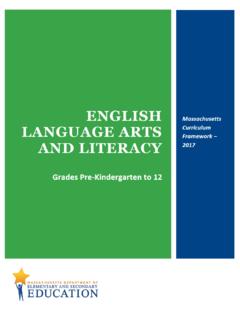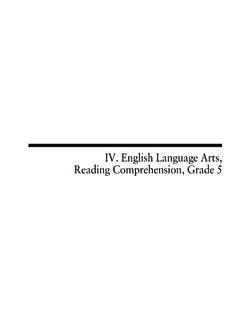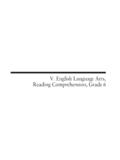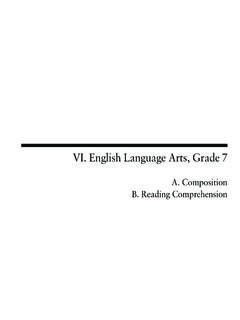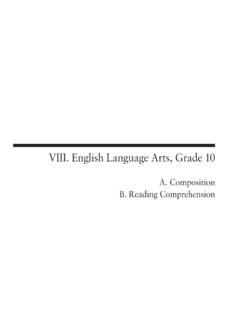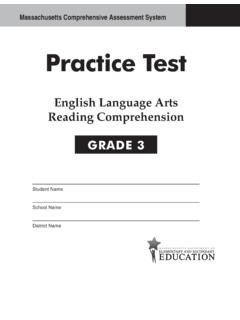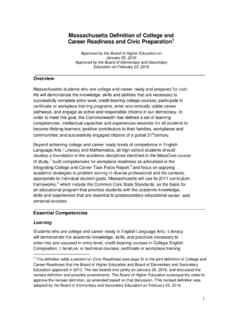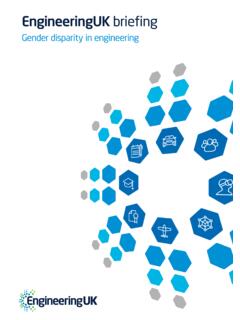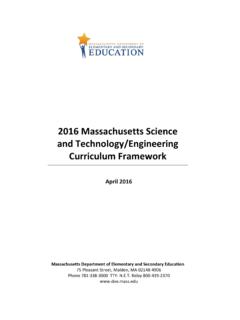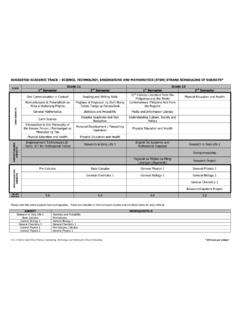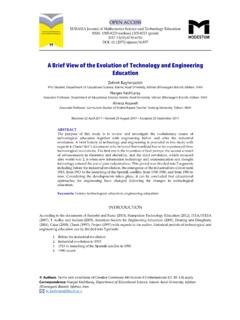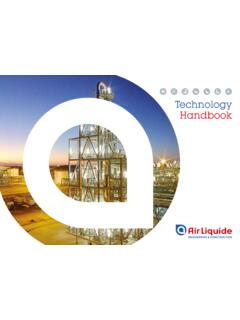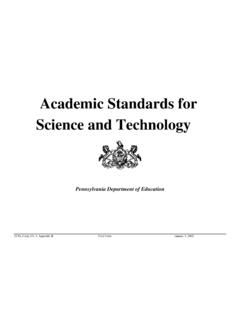Transcription of Science and Technology/Engineering Learning Standards
1 Science and Technology/Engineering Learning Standards Overview of the Standards The Massachusetts Standards are an adaptation of the Next Generation Science Standards (NGSS) based on the Framework for K 12 Science Education (NRC, 2012). This is done so educators and districts can benefit from commonality across states, including use of NGSS-aligned resources created elsewhere. Common features include: Integration of Science and engineering practices. Grade-by-grade Standards for elementary school that include all STE disciplines. Application of Science in engineering contexts. While the Massachusetts STE Standards have much in common with NGSS, public input from across the Commonwealth during the development of the Standards identified several needed adaptations for Massachusetts: Include Technology/Engineering as a discipline equivalent to traditional sciences.
2 Include only two dimensions (disciplinary core ideas and Science and engineering practices) in the Standards , while encouraging the inclusion of crosscutting concepts and the nature of Science in the curriculum. Balance broad concepts with specificity to inform consistent interpretation. Maintain the Massachusetts model of introductory high school course options. Structural Features of the Standards The STE Standards are presented using a consistent structure: The pre-K 8 Standards are presented by grade, with each grade focused on a grade-level theme that links the Standards and all four STE disciplines (see Appendix V). High school Standards are provided for five common introductory-level courses. Standards are organized by disciplinary core ideas, consistently referenced throughout the grades.
3 For Standards that are not aligned to NGSS ( , Standards added by Massachusetts) an (MA) has been added to the label. A sterisks (*) designate Standards that have an engineering design application. Labeling/Coding of the Standards The Massachusetts STE Standards are labeled using the NGSS system, as shown here: The first component of each label indicates the grade (pre-K to grade 8) and/or span (middle or high school). The next component specifies the discipline and core idea. Finally, the number at the end of each label indicates the particular standard within the related set. Maintaining the labeling system from NGSS is intended to allow Massachusetts educators access to curriculum and instruction resources developed across the country.
4 This occasionally results in Standards that appear to be out of sequence or skip a number (because some NGSS Standards are not included in the Massachusetts Standards ), but the benefits of consistency with NGSS outweigh those of renumbering. Note that the order in which the Standards are listed does not imply or define an intended instructional sequence. Components of the Standards Many Standards include clarification statements ( which supply examples or additional clarification to the Standards ) and state assessment boundary statements (which are meant to specify limits to state assessment). Note that these are not intended to limit or constrain curriculum or classroom instruction: educators are welcome to teach and assess additional concepts, practices, and vocabulary that are not included in the Standards .
5 Relationship of Standards to Curriculum and Instruction The Standards are outcomes, or goals, that reflect what a student should know and be able to do. They do not dictate a manner or methods of teaching. The Standards are written in a way that expresses the concept and skills to be achieved and demonstrated by students, but leaves curricular and instructional decisions to districts, schools, and teachers. The Standards are not a set of instructional activities or assessment tasks. They are statements of what students should be able to do as a result of instruction. In particular, it is important to note that the scientific and engineering practices are not teaching strategies they are important Learning goals in their own right; they are skills to be learned as a result of instruction.
6 As the Standards are performances meant to be accomplished at the conclusion of instruction, quality instruction should engage students in multiple practices throughout instruction. Students cannot comprehend scientific practices, or fully appreciate the nature of scientific knowledge itself, without Learning the Science and engineering practices. This Framework uses the term practices instead of terms such as inquiry or skills to emphasize that the practices are outcomes to be learned, not a method of instruction. It is also important to note that the Standards identify the most essential material for students to know and do. They are not an exhaustive list of all that could be included in a student s Science education; students should not be prevented from going beyond them where appropriate.
7 Teachers have the flexibility to arrange the Standards in any order within a grade level and add areas of study to suit the needs of their students and Science programs. Including various applications of Science , such as biotechnology, clean energy, medicine, forensics, agriculture, or robotics, would nicely facilitate student interest and demonstrate how the Standards are applied in real-world contexts (see Appendix IX). References National Research Council (NRC). (2012). A framework for K-12 Science education: Practices, crosscutting concepts, and core ideas. Washington, DC: The National Academies Press. Use of Selected Terms This section clarifies the intended use of certain terms in the Standards . engineering Design Design problem: A n articulation of a problem to be solved or a thing to be improved that addresses a personal, communal, or societal need.
8 Engaging in or addressing a design problem results in a product (a physical thing or a process). Scale Local: Describes an area relevant to what is being studied, generally a local community or small region ( , an area of a state). Does not have to be near where the student lives, although that can be the area under study. A local area can also be, for example, a place in Costa Rica if the topic of study is a rain forest, or a place in the Arctic if that is being studied. Regional: Generally refers to a statewide or multistate perspective relative to what is being studied or, if on another continent, approximately a country or small set of countries that constitute a regional scope. Material Properties Different properties of materials are specified and used throughout the Standards .
9 The table below shows the grade span at which each property is introduced. Once introduced at one grade level, the property may be used, referred to, or expected in any later grade. A check mark ( ) indicates that the property is specified again in the later grade span. Pre-K 2 3 5 6 8 HS Absorbency Color Flexibility Hardness Texture Electrical conductivity Response to magnetic forces Reflectivity Solubility Thermal conductivity Boiling point Density Ductility Flammability Melting point Elasticity Plasticity Reactivity Resistance to force Surface tension Vapor pressure . Grades Pre-K 2: Overview of Science and engineering Practices The development of Science and engineering practices begins very early, even as babies and young children inquire about and explore how the world works.
10 Formal education should advance students development of the skills necessary to engage in scientific inquiry and engineering design. These are the skills that provide the foundation for the scientific and technical reasoning that is so critical to success in civic life, postsecondary education, and careers. Inclusion of Science and engineering practices in Standards only speaks to the types of performances students should be able to demonstrate at the end of instruction at a particular grade; the Standards do not limit what educators and students should or can be engaged in through a well-rounded curriculum. Pre-K through grade 2 Standards integrate all eight Science and engineering practices. Pre-K Standards ask students to demonstrate an ability to ask questions, set up simple investigations, analyze evidence, observations, and data for patterns, and use evidence to explain or develop ideas about how phenomena work.


